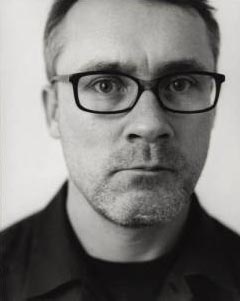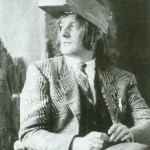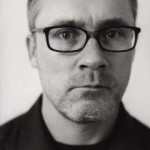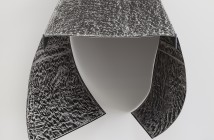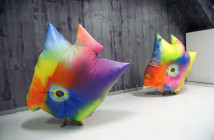The social collective is gaining steam once again in the art world. Mass MoCA gave the 1990s its Interventionists’ retrospective, Flux(us) groups are flourishing in Queens, and Boston has its staple collective scoping out every First Friday (1). Groups of artists are appearing everywhere and they all seem to be sick of the white cube (again), favoring the streets and their own alternative spaces, and - above all-the shared company of strangers.
And yet at the same time this spring saw the “Artist” in its most singular form – the “bad boy” – back in full swing. This anti-Hero of sorts comes packaged in a daring individual that always seems to have the art scene by its balls. The work of two such types, Damien Hirst (b. 1965) and Martin Kippenberger (1953 – 1997), seemed to spring up with the crocuses around New York and Boston this past March. Last month, the Museum of Fine Arts, Boston, wrapped up its pleasantly truncated Hirst retrospective, while theGagosian Gallery, Chelsea, showed his latest wares: a group of 30 photorealist paintings, along side a gallery row newly stocked with canvases once again. Martin Kippenberger, who would have turned fifty in 2003, if it were not for his untimely death in 1997, hit the trifecta of shows in New York; Luthring Augustine Gallery exhibited his numerous takes on the self-portrait, the NYEHAUS had his ambitious and global project, METRO Net in The Bermuda Triangle: Syros, Paris Bar and Dawson City, and finally, the Gagosian uptown, 980 Madison, paralleled him with Hirst by featuring a 1981 photorealist painting series, Dear Painter, paint for me (Leiber Maler, male mir. . ..
And so Gagosian and the rest of the world have handed us these two artists on a platter, side by side. Are Kippenberger’s ‘posters’ the precedent for Hirst? Maybe - and then again may be not.
It is perhaps this last show that best essentializes Kippenberger’s artistic practice (if I may be so crude). These twelve oversized paintings comprised the artist’s first museum exhibition back in 1981 at Berlin’s New Society for Fine Arts (Neue Gesellschaft für Bildende Kunst) for which Kippenberger hired a movie poster painter, Werner, to copy a selection of photographs. About one-third feature Kippenberger himself, most often in his standard uniform of a business suit and tie, save one in which he slouches in a pair of baggy white underwear (his version of Captain Underpants that resurfaced in a later self-portraiture series). A large, sickly sweet puppy looms in one canvas, while in a copy of a Polaroid, a German TV actor grins in another. The overall comic tone was set with the show’s original exhibition catalogue, produced by the artist, titled: Kippenberger: Through Puberty to Success (Durch die Pubertät zum Erfolg). The work has been generally noted as a take on the ever-popular Neo-Expressionist, and second generation Neue Wilde, school of painting that dominated Germany’s art scene in the early 80s. The cool surface of the photo-based canvases stood like glass against the thick paint of Baselitz or Lupertz’s work, both of which were directly quoting Expressionist painting of the 1910 - 1920s, Germany’s pre-World War II modern art heritage. Having hired a commercial painter to execute a bunch of “self-portraits” was yet another jab at the notion of painting’s supposed psychological power of expression. And so began the career of Martin Kippenberger – conceptual, comical and just a tad obnoxious.
Though Kippenberger gained something like celebrity / notoriety in Europe during the 80s and 90s, his US presence has always been more understated – that is – until now. In March, “I Heart Kippenberger” bumper stickers, a remnant of an earlier project, floated through arty mailboxes all over New York. A German Jeff Koons with a splash of Warhol, Kippenberger cultivated a distinct persona and the reputation as an Art Bad Boy. In Germany, he was the first artist to earn the title of a Selbstdarstellar, a self-promoting performer, a term usually bestowed upon egomaniacal actors and politicians. He was loud and drunk at gallery openings while his work constantly quoted, critiqued, and/or mocked the artworld. In the span of two decades he produced an almost grotesque amount of work in just about every form of media – paintings, drawings, prints, sculpture, installation, you name it, most of them either hastily done or done by assistants. There’s no wonder he could posthumously fill three simultaneous shows in a single city.
Which brings us back to Damien Hirst, another young and feisty artist of his day. The notorious organizer of the Freeze exhibition in 1988, the unofficial leader of the rowdy YBAs, and the man who gave us formaldehyde sharks that just recently sold for an unprecedented $12 million, has now, once again given the art world something to buzz about. His latest offering, the show The Elusive Truth at Gagosian’s southern local consists of photo-based paintings copied from found media images, all (decisively badly) painted by assistants with just the finishing touches by Mr. Hirst. (Think: Thomas Kinkade.) Keeping in line with his usually macabre/medical themes, the large paintings show us heroin addicts, bombing victims, a large skull, and Hirst’s favorite: pills and hospitals.
The similarities between Hirst and Kippenberger are startling. In addition to their public notoriety and varied oeuvres, both artists entered the restaurant business, perhaps to make good on the idea that Art is nourishment. Hirst’s Pharmacy closed recently while Kippenberger decided to buy an interest in an Italian restaurant, Capri, in Venice, CA, during an extended visit to Los Angeles in the mid-1990s. The reason: to get decent spaghetti bolognaise in California. Beyond pasta, however, the two artists clearly both rely on a certain amount of shock value to push an agenda that is critical of art itself.
But this is also exactly where the two men diverge as artists. Whereas Kippenberger used humor and brashness as his critical device, no such levity is present in Hirst’s ongoing dialogue with art history. Despite Hirst comic demeanor, he takes art seriously. He critiques it within a formal context, remaining in the arena set by art’s own past.
The MFA show, A Selection of Works by Damien Hirst from Various Collections, best clarifies this point (2). A single gallery was given over for what turned out to be a fairly comprehensive, well-edited retrospective of Hirst’s work of the last 10 years. Seven iconic pieces were featured; Away from the Flock, 1994, a formaldehyde soaked lamb in a Sol LeWitt-esque cuboid frame, a dot painting, a medicine chest, a more recent oval painted patterned with butterfly wings, a room-size diorama of a scientist at work called The Collector, a spinning spin-art painting, and perhaps the most clever of them all, Hirst’s answer to monochromic painting – a black, fly-encrusted, canvas ominously titled, Judgement Day.
With these choice works, the show managed to pick out Hirst’s primary theme - a riff on Art History and in particular the abstraction that was so dominant mid-late-twentieth century. Minimalist cubes are everywhere but filled with old medicine boxes or a lamb in formaldehyde – dual icons of life and death. Such intense symbols of meaning infuse these shapes that were once presented as ideal forms. Art’s autonomy and objecthood became packaged in metal cubes and grid-like structures in the Minimalist lexicon of LeWitt and Donald Judd. Hirst, in turn, uses life and life-extending devices – butterfly wings, animals, medicine – to inhabit these same structures, and perhaps, to reject the very notion of ideal form. A self-proclaimed Romantic, Hirst returns to the grand themes of the human condition - life and death - but is not content to focus on them alone. Rather he injects his romanticism into the forms of the past generation, as if to reform and harness the validity of the past in his own image. Though appropriationist tactics are run-of-the-mill in most art practice today, they are a double-edged sword. While past art is being modified, literally, within a different context, the source ideas and ideologies associated with it can never be fully excised from the new work. Thus, by using Minimalists forms, Hirst remains in Judd and LeWitt’s formal playing field.
And so his latest venture, representational painting, seems to fall in line with Hirst’s general discomfort with complete abstraction. As the photorealist painters of the 70s have taught us, copying photographs is a viable reiteration of life experience in our media-saturated society.
Though he made his name as a sculptor, Hirst has been straddling the painting and sculpture divide as early as his days before art school when he was producing collages. That, he explains, was how he ended up at Goldsmiths College (the art school from which his name reached headlines) since it was one of the few programs that did not make its students chose a painting or sculpture course - there was simply an Art course. Painting has thus been with Hirst for some time.
The MFA featured one such spot painting, Arginine, 1994, a white canvas with an even grid of colored circles (Arginine is a cardiovascular medicine- another link in Hirst’s art and life thematics). In The Elusive Truth, the pills are fleshed out with shading into the realm of representational painting.
And so the latest paintings appear to be an extension of the same riff. This time, Hirst is attacking abstraction where it hurts - in painting. He’s decided to return the image back to the canvas- giving it primacy over the material and somewhat empty idea of expression. Regarding this series, Hirst recently mused, “I think you should be hit by the image, then you find out it’s a painting.”
And so, our two brash individuals, Hirst and Kippenberger come off as two sides of the same critical coin. They pose as anti-heroes – one with a smile and the other with scowl.
- Martin Kippenberger (1953 – 1997), cultivated a distinct persona and the reputation as an art bad boy.
- Whereas Kippenberger used humor and brashness as his critical device, no such levity is present in Damien Hirst’s ongoing dialogue with art history.
(1) Mass MoCA’s exhibition The Intervnetionists: Art in the Social Sphere.
(2) I'd like to thank William Stover of the MFA. Much of the following text is indebted to and informed by his insights and comments about Hirst's work.
Links:
Mass MoCA
Museum of Fine Arts, Boston
Neue Gesellschaft für Bildende Kunst
Flux Factory
Gagosian Gallery
Luthring Augustine Gallery
"A Selection of Works by Damien Hirst from Various Collections" was on view until April 24th in the Foster Gallery at the Museum of Fine Arts, Boston.

